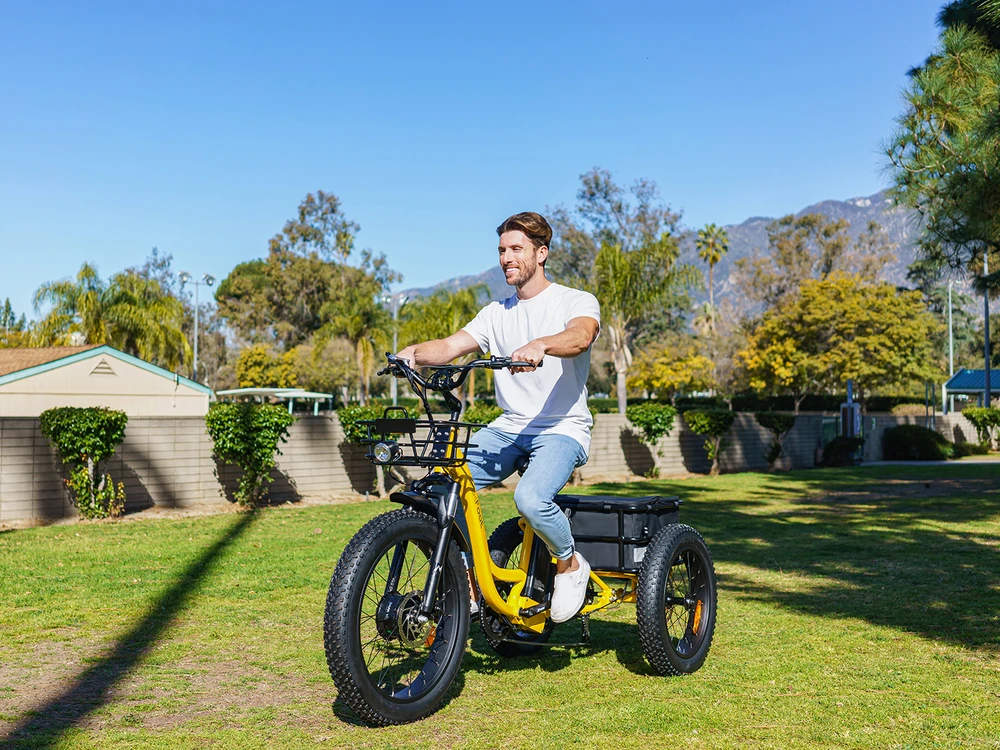Electric trikes have gained popularity in recent years, offering a versatile and eco-friendly transportation alternative. As different models emerge on the market, the choice between hub motor and crank drive motor becomes a crucial consideration for potential buyers. In this article, we'll compare these two motor types and discuss which is better for an electric trike.
Before diving deeper into the topic, don't forget that you can get a $100 discount on your MF-30 electric trike purchase by using the discount code GP30 at Maxfoot.
Definition and Purpose of Electric Trikes
An electric trike, also known as an e-trike, is a three-wheeled vehicle that uses an electric motor to power its movement. These trikes have become increasingly popular among commuters, delivery services, and elderly people for their ease of use, comfort, and stability.
Importance of Choosing the Right Motor for an Electric Trike
Choosing the right motor is crucial for the performance, efficiency, and comfort of an electric trike. The motor type determines its power output, torque, hill-climbing ability, and overall speed. It also affects the battery life and maintenance requirements of the vehicle.
Hub Motor
Hub motors are typically located in the center of either the front or rear wheel. The motor directly powers the wheel it's connected to, allowing for a simpler, less complicated design.
Pros:
-
Easy maintenance: With fewer moving parts and no external gears or chains, hub motors require less maintenance than crank drive motors.
-
Quiet operation: Hub motors tend to be quieter than their crank drive counterparts.
-
Cost-effective: In general, hub motors are less expensive than crank drive motors.
Cons:
-
Lower torque: Hub motors provide less torque compared to crank drive motors, which can be a disadvantage when climbing hills or carrying heavy loads.
-
Limited versatility: As hub motors directly power the wheel, they might struggle with uneven terrain or when towing a trailer.
Types of Hub Motors
-
Geared hub motors: These use a small gear system inside the motor to increase torque and power output.
-
Direct drive hub motors: These use a larger number of coils to generate more torque and power output.
Crank Drive Motor
Crank drive motors, also known as mid-drive motors, are located in the middle of the bike, near the pedals. They deliver power directly to the bike's chain, offering more precise control over the gears.
Pros:
-
Higher torque: Crank drive motors provide greater torque, making them well-suited for tackling steep inclines and handling heavy loads.
-
Better weight distribution: The central location of the motor contributes to improved weight distribution and balance, resulting in better overall handling.
-
Greater efficiency: Crank drive motors offer better energy efficiency, prolonging battery life during challenging rides.
Cons:
-
Higher maintenance: With more moving parts, including the chain and gears, crank drive motors require regular maintenance.
-
Increased noise: Crank drive motors can be louder than hub motors, which might be bothersome to some riders.
-
Higher cost: Generally, crank drive motors come with a heftier price tag than hub motors.
Types of Crank Drive Motors
-
Fang series motors: These motors have a compact and lightweight design with a high torque output.
-
Bosch Performance line motors: These motors have a high power output and efficient performance, suitable for long-distance riding.
Comparison between Hub Motor and Crank Drive Motor
The choice between hub motor and crank drive motor depends on several factors, including:
Power and Torque
Crank drive motors provide higher power output and torque compared to hub motors, making them suitable for hilly terrains and heavy loads.
Efficiency and Speed
Crank drive motors are more efficient and provide a longer battery life compared to hub motors. They also offer better speed control and can maintain a consistent speed on varying terrain.
Hill Climbing Ability
Crank drive motors perform better on steep inclines and challenging terrains compared to hub motors.
Reliability and Maintenance
Hub motors require less maintenance and are easier to replace or repair compared to crank drive motors.
Comfort and Smoothness
Crank drive motors provide a smoother and more natural riding experience, thanks to their pedal assistance feature.
Noise Levels
Hub motors operate quietly compared to crank drive motors, which can produce a significant amount of noise.
Conclusion
When choosing between a hub motor and a crank drive motor for your electric trike, consider your specific needs and preferences. If you require a simple, low-maintenance, and cost-effective option, a hub motor may be the perfect choice. On the other hand, if you're looking for greater torque, efficiency, and handling capabilities, a crank drive motor might be the better option.
Ready to purchase your ideal electric trike? Don't forget to take advantage of the $100 discount on the MF-30 three-wheel electric bikes from Maxfoot by using the discount code GP30 at checkout!
FAQs
What type of motor is the best for an electric trike?
The best motor type depends on the rider's requirements, terrain, and intended use. Hub motors are suitable for flat and urban terrain, while crank drive motors are better for hilly terrain and long-distance touring.
Can I retrofit an electric trike with a different motor?
Yes, electric trikes can be retrofitted with a different motor type, but it requires professional installation and adjustments.
Do hub motors or crank drive motors require more maintenance?
Crank drive motors require more maintenance and adjustment for optimal performance compared to hub motors.
How long does it take to charge the battery of an electric trike?
The charging time of an electric trike battery depends on the battery capacity and charger specifications. Generally, it takes 4-6 hours to charge a 48V battery.
Are there any safety regulations regarding electric trikes?
Electric trikes are subject to the same safety regulations as conventional bicycles and must comply with motor power and speed limits and other regulations in their respective regions.


No comments yet